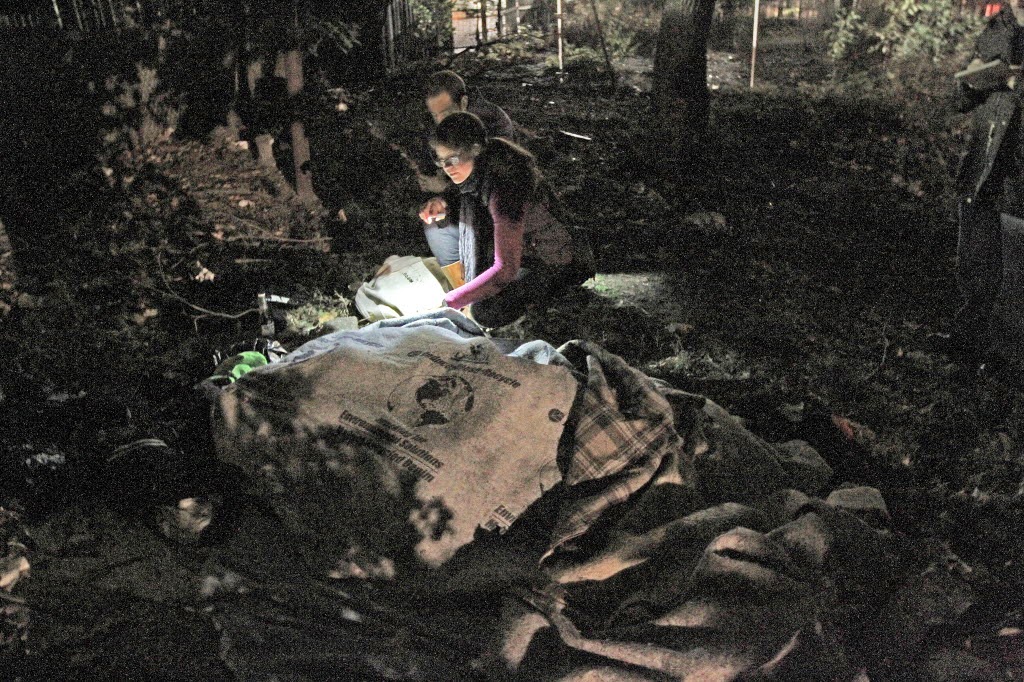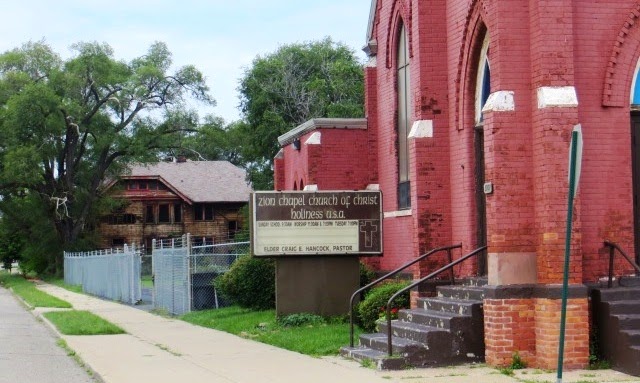Thirty years ago, I wrote a six-part series for The Providence Journal (The Journal-Bulletin then) about the creation of Rhode Island's community system. This is one of the stories from that "Building New Lives" series.
R.I. praised for its care of mentally disabled
G. WAYNE MILLER
Publication Date:
November 28, 1984
Page:
A-01
Section:
NEWS
Edition:
ALL
Part four of six parts.
[NOTE: The "Building New Lives" series examined both the mental health
system and the system for care of the developmentally disabled, people
who in 1984 were labeled "retarded" -- and many of whom lived in the
now-closed Dr. Joseph H. Ladd Center in Exeter.]
 |
| This is how the mentally ill were treated in RI 50 years ago. Courtesy: Providence Journal. For more on the institutional era, click here. |
A
sun-drenched afternoon in August. The streets of Manhattan's Bowery
stink of garbage and urine and cheap booze, and flies are buzzing
everywhere, and everything's moving slow, and it's steamy hot, dog-day
hot.
For eight years, since his discharge from a public
psychiatric hospital, William J. Moody has lived on these streets. For
eight years, he has carried his earthly possessions in a valise, a
shopping bag and a tattered gym bag. For eight years, he has been unable
to find a job, or an apartment he can afford.
"A Bohemian," he fancies himself. "You know, more or less in a clean, bummy fashion."
When he has the money, Moody eats sardines and mayonnaise, or treats
himself to Chinese food or a bowl of noodle soup. When he doesn't, he
picks through dumpsters. At night, when the weather is fair, he sleeps
in parks. When it isn't, he rides the subway until dawn or finds a steam
grate or a warm tunnel.
Moody shuffles along East Third Street,
a once respectable neighborhood gone to seed. Most of the buildings are
boarded, run down, covered with unintelligible graffiti, revolutionary
slogans, posters for new-wave bands named "Live Skull," "Brooklyn Dead"
and "Alien Love."
Around the corner, men congregate near the
Palace Hotel, a tumble-down flophouse. The men are young, middle-aged,
old. Some snooze. Others drink, play cards, swap stories in gravelly
voices. Their faces are tired and dirty. Their clothes are grimy. There
is no dignity on these streets, only survival.
Moody gives his
age as "60s." He is a tall, slim, toothless man with a crazy, crackling
laugh and a fondness for clean clothes and porkpie hats.
Moody
also is a schizophrenic. During his years on the streets, he has been
spit on, beaten, stabbed, robbed, arrested. He has been thrown out of
rooming houses, kicked off buses, denied medical care.
He is a
victim - a victim of deinstitutionalization. In contrast to Rhode
Island, where the movement has succeeded, New York is a national
disgrace.
Like thousands of New York City's estimated 40,000
street people, Moody, a onetime drummer in a big band, spent years in an
institution. Like the others, he was discharged without an apartment or
a job, without psychiatric care, without much concern for what would
happen to him.
"These people aren't getting shelter, food or
clothing. Some are dying," says Dr. Frank R. Lipton, assistant professor
of clinical psychiatry at New York University Medical Center. "For this
group of people, we aren't even at square one. For these people, it's a
mess."
NATIONALLY, deinstitutionalization has a mixed record.
One of the most successful states has been Rhode Island, a national
leader in the movement.
Other states, Wisconsin, Nebraska and
Vermont among them, also have spent the time and money to care for
people who have left institutions. A few, including Oklahoma and
Arkansas, have rejected the movement and continue to operate large,
overcrowded, unsafe institutions.
Still others, such as New York
and California, rushed to empty institutions without putting in place
all of the programs longtime patients must have to live decently in the
community. In New York, 60,000 patients of state psychiatric hospitals
have been released since 1965; estimates of those who need community
help, but don't get it, run to 25 percent or more.
One result
was predictable: a mounting cry to turn back the clock a half-century to
when severely disabled people were routinely packed off to asylums.
"Attempts since the 1960s to 'deinstitutionalize' these patients and
treat them in the community have succeeded only partially, and the
failures are increasingly visible on the grates and gutters of urban
America," the Wall Street Journal reported in August.
A
Massachusetts Senate committee, in a report released two months ago,
faulted that state's mental health department for being too zealous in
its deinstitutionalization. The committee urged officials to consider
reopening mental hospitals.
"The committee's investigation has
uncovered sound evidence that hundreds upon hundreds of former patients
are winding up in jail cells, emergency rooms, emergency shelters and
walking the streets . . ." the report stated.
"One need only to
walk the streets of Boston, Worcester or Springfield, or any other urban
center, to see real-life examples of deinstitutionalization gone sour."
And in California, a nine-month state commission study concluded this
year that group homes in the state were plagued by "abusive,
unhealthful, unsafe and uncaring conditions . . . some residents are
actually killed in facilities each year."
RHODE ISLAND places near the top among states that have done the job of deinstitutionalization well.
Yes, there are gaps in service, and there are some homeless mentally
disabled people, but experts agree Rhode Island has spent the time and
money to ensure that most people who leave the Institute of Mental
Health and the Dr. Joseph H. Ladd Center will be able to live at
something better than survival level.
Experts in mental health
and retardation with national perspectives speak highly of how well
Rhode Island has managed deinstitutionalization, and many have come here
for firsthand looks. Not coincidentally, the first legislation
encouraging national deinstitutionalization was introduced by a Rhode
Island senator, John H. Chafee.
"You can see in a comparison of
similar states with similar size how one can do a better job," says Neal
B. Brown, director of the National Institute of Mental Health's
community support program. "Rhode Island is doing a better job. A
tremendous amount has been done in the last few years."
Harry C.
Schnibbe, executive director of the National Association of State
Mental Health Program Directors, agrees. "It's working a hell of a lot
better than in other places, I can say that," he remarks. "People are
being taken care of when they get out of the facilities."
"There
are only about three places in the country where there has been
dramatic and consistent and persistent community development," says
Thomas Nerney, a consultant to the U.S. Office of Special Education and
Rehabilitative Services. "Rhode Island is one of them."
One
recent survey by the National Institute of Mental Health, for example,
shows that Rhode Island annually spends $61.56 per capita for private
and public mental health services. Only three states spent more.
Another survey, by the University of Illinois at Chicago, showed that
Rhode Island spent about $26 per capita for community services for the
retarded. Only two of the 50 states spent more.
"Before you left the hospital, did anyone give you advice on how you were going to get by?"
Moody: "I was inquirin' while I was there but I couldn't make heads or tails out of what the people were sayin'."
"Do you have an income?"
"Yeah, I'm gettin' Social Security and an Army pension. About $450 per
month. Four hundred fifty in 30 days. That's not much money in this
city."
"Would you like to work?"
"Sure. Yeah. But you
can't get anything these days. Everything seems to be filled. Then, on
top of that, like I say, I don't have any identification. I can't tell
them I belong to the union."
"What about an apartment?"
"Well, now, if I could afford it, and it more or less fitted my
particular curricula, yeah, I'd go for it. I found a couple of places
like that, but they're particular. You just can't get in there."
"What if someone found you a place. A state or city agency, say?"
"I'd love it. I'd go stark ravin' insane over it. Knowin' that I'd have
my own private apartment? Would I like it? I'd end up paintin' the
whole place in nothin' flat] Sure] I'd be crazy about that]"
RHODE ISLAND'S secret has been a combination of money, leadership, and a
consensus that moving people out of institutions is cost-effective and
humane. In few states has there been such agreement among legislators,
the public and experts in the field.
These are among the ingredients of Rhode Island's success:
* Time.
Unlike other states, which rushed to empty institutions in the 1960s,
Rhode Island didn't get into high gear until a decade later. That
comparatively late start gave the state the chance to learn from others'
mistakes.
Says Leona Bachrach, professor of psychiatry at the
University of Maryland School of Medicine: "I think it's probably okay
to suggest that you overcame some of the errors of some of the other
states that proceeded very rapidly."
The majority of people
leaving institutions were adequately prepared for new lives outside;
people who had trouble outside were returned to the institutions until
they were ready to try again. That was crucial. Large numbers of
obviously disturbed people acting strangely or offensively would have
created great public pressures to slow, or reverse, the movement.
* Size.
Rhode Island is a small state with only one public psychiatric hospital
and a single public institution for the retarded - a built-in advantage
to the architects of the movement. Many of the problems of larger
states, including New York, have been related to the sheer magnitude of
the task.
"New York inherited a terrible problem of numbers,"
says Joseph J. Bevilacqua, former director of the Rhode Island
Department of Mental Health, Retardation and Hospitals. "New York had
literally 40, 50 institutions. The calculus to move that number into
community services is horrendously complicated. It's a gargantuan
problem."
* Administrative leadership.
Both Bevilacqua
and his successor, MHRH director Thomas D. Romeo, have made
deinstitutionalization a top priority, fighting to channel money and
resources away from Ladd and the IMH into community programs. They also
brought on board, or promoted, division-level bureaucrats who shared
their vision.
* Dedicated professionals.
Without
competent front-line staff, quality services cannot be consistently
provided. Although a few public and private workers have little interest
in the people they serve, Rhode Island has been able to attract
primarily qualified, dedicated professionals willing to work long hours
at low pay in what is acknowledged to be a high "burnout" field.
* Community advocates.
One of the driving forces behind the movement has been the Rhode Island
Association for Retarded Citizens. Less powerful, but still important,
have been the Mental Health Association of Rhode Island and the Rhode
Island Council of Community Mental Health Centers.
* Public support.
Although many group homes were met with stiff opposition in
neighborhoods around the state, Rhode Island voters have never turned
down a bond issue for development of community programs. Since 1967, 10
bonds totalling $90 million (including money for the IMH and Ladd) have
been approved. The latest was an $8-million bond passed on Nov. 6.
Says Schnibbe: "That is one distinction that Rhode Island has that is
substantially different from the rest of the country. Everybody wishes
they could use it."
* Political leadership.
Many states
have been frustrated by legislative squabbles over cost and purpose. For
the last decade, the General Assembly and the governor have been
committed to the program. In particular, Governor Garrahy and former
Senate Majority Leader Rocco A. Quattrocchi have been key figures in
mustering support.
* Federal money.
Unlike some states,
Rhode Island has been unusually successful in attracting federal
dollars. Even under the Reagan administration, the state has managed to
get millions annually for community programs.
* Monitoring and control.
Although local providers administer many programs, allowing for
flexibility and innovation state bureaucracies often lack, Rhode Island
has kept control of overall programs through their financing. In those
few instances where community workers have been found negligent, the
state has moved quickly to discipline them or bring court charges.
* Legal action.
A 1977 federal suit by RIARC against the state accelerated the movement
of people from Ladd and led to improvements at the institution.
* Media attention.
Investigations in the 1970s by the Rhode Island media, notably the
Journal-Bulletin, focused attention on deplorable conditions at the IMH
and Ladd. That attention made it impossible for legislators and MHRH
administrators to ignore the problems of the state's mentally disabled,
in or out of institutions.
















































